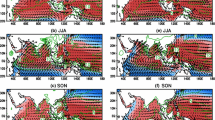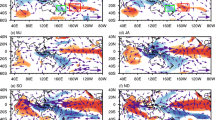Abstract
In this paper we use sea surface height (SSH) derived from satellite altimetry and an analytical linear equatorial wave model to interpret the evolution of the Indian Ocean Dipole (IOD) in the framework of recharge oscillator theory. The specific question we address is whether heat content in the equatorial band, for which SSH is a proxy, is a predictor of IOD development as it is for El Niño and the Southern Oscillation (ENSO) in the Pacific. We find that, as in the Pacific, there are zonally coherent changes in heat content along the equator prior to the onset of IOD events. These changes in heat content are modulated by wind-forced westward propagating Rossby waves in the latitude band 5°–10°S, which at the western boundary reflect into Kelvin waves trapped to the equator. The biennial character of the IOD is affected by this cycling of wave energy between 5° and 10°S and the equator. Heat content changes are a weaker leading indicator of IOD sea surface temperature anomaly development than is the case for ENSO in the Pacific though because other factors are at work in generating IOD variability, one of which is ENSO forcing itself through changes in the Walker Circulation.
















Similar content being viewed by others
References
Ashok K, Guan Z, Yamagata T (2001) Impact of the Indian Ocean dipole on the relationship between the Indian monsoon rainfall and ENSO. Geophys Res Lett 28:4499–4502
Battisti DS (1988) Dynamics and thermodynamics of a warming event in a coupled atmosphere-ocean model. J Atmos Sci 45:2889–2919
Battisti DS, Hirst AC (1989) Interannual variability in a tropical atmosphere-ocean model: influence of the basic state, ocean geometry and nonlinearity. J Atmos Sci 46:1687–1712
Behera SK, Luo J–J, Masson S, Delecluse P, Gualdi S, Navarra A, Yamagata T (2005) Paramount impact of the Indian Ocean dipole on the east African short rains: a CGCM study. J Clim 18:4514–4530
Brandt P, Dengler M, Rubino A, Quadfasel D, Schott F (2003) Intraseasonal variability in the southwestern Arabian Sea and its relation to the seasonal circulation. Deep-Sea Res II 50:2129–2141
Cai W, Pan A, Roemmich D, Cowan T, Guo X (2009) Argo profiles a rare occurrence of three consecutive positive Indian Ocean Dipole events, 2006–2008. Geophys Res Lett 36:L08701. doi:10.1029/2008GL037038
Cai W, van Rensch P, Cowan T, Hendon HH (2011) Teleconnection pathways of ENSO and the IOD and the mechanisms for impacts on Australian rainfall. J Clim 24:3910–3923
Ducet N, Le Traon PY, Reverdin G (2000) Global high-resolution mapping of the ocean circulation from TOPEX/POSEIDON and ERS-1/2. J Geophys Res 105:19477–19498
Feng M, Meyers G (2003) Interannual variability in the tropical Indian Ocean: a two-year time-scale of Indian Ocean Dipole. Deep-Sea Res 50:2263–2284
Feng M, Wijffels S (2002) Intraseasonal variability in the south equatorial current of the east Indian Ocean. J Phys Oceanogr 32:265–277
Feng M, Meyers G, Wijffels S (2001) Interannual upper ocean variability in the tropical Indian Ocean. Geophys Res Lett 28:4151–4154
Foltz GR, McPhaden MJ (2010a) Abrupt equatorial wave-induced cooling of the Atlantic cold tongue in 2009. Geophys Res Lett 37:L24605. doi:10.1029/2010GL045522
Foltz GR, McPhaden MJ (2010b) Interaction between the Atlantic meridional and Nino modes. Geophys Res Lett 37:L18604. doi:10.1029/2010GL044001
Gadgil S, Vinayachandran PN, Francis PA, Gadgil S (2004) Extremes of the Indian summer monsoon rainfall, ENSO and equatorial Indian Ocean oscillation. Geophys Res Lett 31:L12213. doi:10.1029/2004GL019733
Gordon A (2005) Oceanography of the Indonesian seas and their throughflow. Oceanography 18:14–27
Horii T, Hase H, Ueki I, Masumoto Y (2008) Oceanic precondition and evolution of the 2006 Indian Ocean Dipole. Geophys Res Lett 35:L03607. doi:10.1029/2007GL032464
Hermes JC, Reason CJC (2008) Annual cycle of the South Indian Ocean (Seychelles-Chagos) thermocline ridge in a regional ocean model. J Geophys Res 113:C04035. doi:10.1029/2007JC004363
Horii T, Masumoto Y, Ueki I, Hase H, Mizuno K (2009) Mixed layer temperature balance in the eastern Indian Ocean during the 2006 Indian Ocean dipole. J Geophys Res 114:C07011. doi:10.1029/2008JC005180
Horii T, Ueki I, Hanawa K (2012) Breakdown of ENSO predictors in the 2000s: decadal changes of recharge/discharge-SST phase relation and atmospheric intraseasonal forcing. Geophys Res Lett 39:L10707. doi:10.1029/2012GL051740
Huang B, Kinter JL III (2002) Interannual variability in the tropical Indian Ocean. J Geophys Res 107:3199. doi:10.1029/2001JC001278
Iizuka S, Matsuura T, Yamagata T (2000) The Indian Ocean SST dipole simulated in a coupled general circulation model. Geophys Res Lett 27(20):3369–3372
Jansen MF, Dommenget D, Keenleyside N (2009) Tropical ocean–atmosphere interactions in a conceptual framework. J Clim 22:550–567
Jin F–F (1997a) An equatorial ocean recharge paradigm for ENSO. Part I: conceptual model. J Atmos Sci 54:811–829
Jin F–F (1997b) An equatorial ocean recharge paradigm for ENSO. Part II: a stripped-down coupled model. J Atmos Sci 54:830–847
Jin F–F, Kim ST, Bejarano L (2006) A coupled-stability index for ENSO. Geophys Res Lett 33:L23708. doi:10.1029/2006GL027221
Kessler WS (2002) Is ENSO a cycle or a series of event. Geophys Res Lett 29:2125. doi:10.1029/2002GL015924
Lau N-C, Nath MJ (2004) Coupled GCM simulation of atmosphere-ocean variability associated with zonally asymmetric SST changes in the tropical Indian Ocean. J Clim 17(2):245–265
Le Blanc J-L, Boulanger J-P (2001) Propagation and reflection of long equatorial waves in the Indian Ocean from TOPEX/POSEIDON data during the 1993–1998 period. Clim Dyn 17:547–557. doi:10.1007/s003820000128
Li T, Zhang Y, Lu E, Wang D (2002) Relative role of dynamic and thermodynamic processes in the development of the Indian Ocean dipole: an OGCM diagnosis. Geophys Res Lett 29(23):2110. doi:10.1029/2002GL015789
Li T, Wang B, Chang C-P, Zhang Y (2003) A theory for the Indian Ocean dipole–zonal mode. J Atmos Sci 60:2119–2135
Luo J–J, Masson S, Behera S, Yamagata T (2007) Experimental forecasts of the Indian Ocean dipole using a coupled OAGCM. J Clim 20:2178–2190
McGregor S, Timmermann A, Schneider N, Stuecker MF, England MH (2012) The effect of the south pacific convergence zone on the termination of El Niño events and the meridional asymmetry of ENSO. J Clim 25:5566–5586
McGregor S, Ramesh N, Spence P, England MH, McPhaden MJ, Santoso A (2013) Meridional movement of wind anomalies during ENSO events and their role in event termination. Geophys Res Lett 40. doi:10.1002/grl.50136
McPhaden MJ (2003) Tropical Pacific Ocean heat content variations and ENSO persistence barriers. Geophys Res Lett 30:1480. doi:10.1029/2003GL016872
McPhaden MJ (2012) A 21st century shift in the relationship between ENSO SST and warm water volume anomalies. Geophys Res Lett 39:L09706. doi:10.1029/2012GL051826
McPhaden MJ, Yu X (1999) Equatorial waves and the 1997–98 El Niño. Geophys Res Lett 26:2961–2964
McPhaden MJ, Meyers G, Ando K, Masumoto Y, Murty VSN, Ravichandran M, Syamsudin F, Vialard J, Yu L, Yu W (2009) RAMA: the research moored array for African–Asian–Australian monsoon analysis and prediction. Bull Am Meteorol Soc 90:459–480
Meinen CS (2005) Meridional extent and interannual variability of the pacific ocean tropical–subtropical warm water exchange. J Phys Oceanogr 35:323–335
Meinen CS, McPhaden MJ (2000) Observations of warm water volume changes in the equatorial Pacific and their relationship to El Niño and La Niña. J Clim 13:3551–3559
Meyers G, McIntosh P, Pigot L, Pook M (2007) The years of El Niño, La Niña, and interactions with the tropical Indian Ocean. J Clim 20:2872–2880
Murtugudde R, McCreary JP Jr, Busalacchi AJ (2000) Oceanic processes associated with anomalous events in the Indian Ocean with relevance to 1997–1998. J Geophys Res 105:3295–3306
Nagura M, McPhaden MJ (2010a) Wyrtki Jet dynamics: seasonal variability. J Geophys Res 115:C07009. doi:10.1029/2009JC005922
Nagura M, McPhaden MJ (2010b) Dynamics of zonal current variations associated with the Indian Ocean dipole. J Geophys Res 115:C11026. doi:10.1029/2010JC006423
Nagura M, McPhaden MJ (2012) The dynamics of wind-driven intraseasonal variability in the equatorial Indian Ocean. J Geophys Res 115:C07009. doi:10.1029/2011JC007405
Rao SA, Behera SK (2005) Subsurface influence on SST in the tropical Indian Ocean: structure and interannual variability. Dyn Atmos Oceans 39:103–135
Rao SA, Behera SK, Masumoto Y, Yamagata T (2002) Interannual subsurface variability in the tropical Indian Ocean with a special emphasis on the Indian Ocean dipole. Deep-Sea Res 49:1549–1572
Saji NH, Yamagata T (2003) Possible impacts of Indian Ocean dipole mode events on global climate. Clim Res 25:151–169
Saji NH, Goswami BN, Vinayachandran PN, Yamagata T (1999) A dipole mode in the tropical Indian Ocean. Nature 401:360–363
Shi L, Hendon HH, Alves O, Luo J–J, Balmaseda M, Anderson D (2012) How predictable is the Indian Ocean Dipole? Mon Weather Rev 140:3867–3884
Shinoda T, Alexander MA, Hendon HH (2004) Remote response of the Indian Ocean to interannual SST variations in the tropical Pacific. J Clim 17:362–372
Song Q, Vecchi GA, Rosati AJ (2008) Predictability of the Indian Ocean sea surface temperature anomalies in the GFDL coupled model. Geophys Res Lett 35:L02701. doi:10.1029/2007GL031966
Tokinaga H, Tanimoto Y (2004) Seasonal transition of SST anomalies in the tropical Indian Ocean during El Niño and Indian Ocean dipole years. J Meteorol Soc Jpn 82:1007–1018
Tozuka T, Luo J-J, Masson S, Yamagata T (2007) Decadal modulations of the Indian Ocean dipole in the SINTEX-F1 coupled GCM. J Clim 26:959–972
Vinayachandran PN, Kurian J, Neema CP (2007) Indian Ocean response to anomalous conditions in 2006. Geophys Res Lett 34:L15602. doi:10.1029/2007GL030194
Wajsowicz RC (2005) Potential predictability of tropical Indian Ocean SST anomalies. Geophys Res Lett 32:L24702. doi:10.1029/2005GL024169
Webster PJ, Moore AM, Loschnigg JP, Leben RR (1999) Coupled ocean-atmosphere dynamics in the Indian Ocean during 1997–98. Nature 401:356–360
Xie S-P, Annamalai H, Schott FA, McCreary JP (2002) Structure and mechanisms of south Indian Ocean climate variability. J Clim 15:867–878
Yamagata T, Behera SK, Luo J–J, Masson S, Jury M, Rao SA (2004) Coupled ocean–atmosphere variability in the tropical Indian Ocean. Earth Clim Ocean-Atmos Interact Geophys Monogr No. 147 AGU:189–212
Yokoi T, Tozuka T, Yamagata T (2008) Seasonal variation of the Seychelles Dome. J Clim 21:3740–3754
Yu X, McPhaden MJ (1999) Seasonal variability in the equatorial Pacific. J Phys Oceanogr 29:925–947
Yu L, Rienecker M (1999) Mechanisms for Indian Ocean warming during the 1997–98 El Niño. Geophys Res Lett 26:735–738
Yu W, Xiang B, Liu L, Liu N (2005) Understanding the origins of interannual thermocline variations in the tropical Indian Ocean. Geophys Res Lett 32:L24706. doi:10.1029/2005GL024327
Yuan D, Liu H (2009) Long-wave dynamics of sea level variations during Indian Ocean Dipole events. J Phys Oceanogr 39:1115–1132
Zhao M, Hendon HH (2009) Representation and prediction of the Indian Ocean dipole in the POAMA seasonal forecast model. Q J R Meteorol Soc 135:337–352
Acknowledgments
This research was supported by NOAA and JAMSTEC. We thank two anonymous reviewers for constructive comments on an earlier version of this manuscript. PMEL Contribution number 3951.
Author information
Authors and Affiliations
Corresponding author
Rights and permissions
About this article
Cite this article
McPhaden, M.J., Nagura, M. Indian Ocean dipole interpreted in terms of recharge oscillator theory. Clim Dyn 42, 1569–1586 (2014). https://doi.org/10.1007/s00382-013-1765-1
Received:
Accepted:
Published:
Issue Date:
DOI: https://doi.org/10.1007/s00382-013-1765-1




